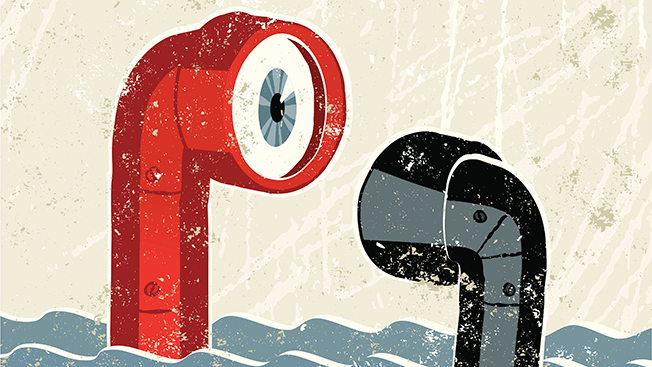adage.com
Beacon Networks and Partners Are Expanding and Becoming More Complex
That Lord
and Taylor app will not only remind shoppers of a deal in the men's shoe
department; it might help retailers find out which entrance consumers used to
get into the mall or what route they took to the Cinnabon.
Lots of
companies have been experimenting with mobile tracking beacons to determine
where shoppers go and what they do in their stores. Now, through a
proliferation of third-party technologies and partnerships among retailers,
shopping centers and mobile tracking firms, they have access to more data than
ever about what consumers did before they got there.
Mobiquity
is among those at the forefront of the trend. The tech firm owns and operates
beacons -- small devices that pick up on signals from mobile phones -- in 240
malls owned by Simon Property Group. The company expects to expand its presence
to 290 malls by July as a result of signing with shopping center owner Macerich
to become its exclusive common area beacon provider earlier this month.
While marketers
have had insight into where people roamed outside of stores through geo-fencing
technologies, recently they've been able to tap into more precise location data
via beacons dotting the shopping landscape in food courts or other areas not
associated with a specific retailer.
The promise
is for retailers to better understand their customers' behavior before and
after they enter their stores and to communicate with them even when they're on
the other side of the mall. For example, a retailer that works with Mobiquity
would be able to anticipate that a shopper who has come to the mall on Tuesdays
via the southwest entrance just might do the same thing again.
"That's
the information they crave," said Dean Julia, co-CEO of Mobiquity
Technologies. "The amount of metadata that we have, we can tell the time
and location for the shopper who has a participating app."
Those apps
are the keys to the system. The company's beacons only recognize signals from
phones that have applications featuring its software development kit or SDK.
That would include the Lord and Taylor app, or non-store-specific apps such as
the Simon Mobile app, or ShopAdvisor for example. Mobiquity gathers the Apple
Identifier for Advertisers or the Android Ad Identifier codes from devices with
apps featuring its SDK. "If you do not have our SDK in your phone we do
not get any data from you," said Mr. Julia.
Its partner
apps -- and most others for that matter -- require people to allow phone
location tracking before downloading them. However, whether consumers who
download apps that connect with these more extensive tracking systems are truly
cognizant of the extent to which their movements outside stores are being
tracked is a question retailers and their partners will have to address as such
technologies proliferate.
"Macerich's
goal is to use the beacon platform to enhance the overall guest experience with
timely and relevant messaging about our amenities, such as our text-based
concierge service, ... same-day package delivery service, retail promotions,
and gift card purchasing," said Petra Maruca, VP of business development
for Macerich. Ms. Maruca declined to discuss details of the transaction with
Mobiquity.
Swirl is
another Mobiquity partner, and its own strategic shift represents the rapidly
evolving and increasingly labyrinthine world of mobile tracking. Formerly a
consumer-aimed shopping app that counted several retailers with Swirl's beacons
installed in their stores, Swirl now focuses on embedding its technology into
other retail apps such as RetailMeNot. RetailMeNot also has partnered with GGP
malls to test beacons and other marketing technologies.
Swirl's
relationship with Mobiquity helps it pair data showing that someone looked at a
handbag in a partner's store with information about the shopper outside the
store. "Otherwise we don't really know anything about you when you're in
the common area," said Hilmi Ozguc, founder and CEO of Swirl.
Swirl
manages campaigns for retailers and shopping app publishers who push out
targeted offers to people who have downloaded their apps. It also runs a retail
app ad exchange that uses mobile beacon data to deliver messages from product
brands while shoppers browse in specific stores selling their wares. For
instance, someone in the cosmetics section of a department store might get a
push notification on her phone from a makeup brand. The company works with
Mobiquity to access data showing where the people who have downloaded apps in
its network are when they're in common areas of malls.
IBM is now
on board, too. The firm will help Mobiquity push its beacon services to
potential clients and assist the mobile tech company in campaign analytics and
integration with retailers.
According
to Swirl, its retail partners own the data it manages on their behalf. Yet,
Mobiquity makes a point of stressing that it owns the data it gathers. The
company allows a retail partner to see the information gathered on people who
have downloaded its app, but does not reveal information about one store's
shoppers to another store, for example. "We do not cross pollinate,"
said Mr. Julia. The information can be viewed in real-time through a reporting
platform.
What does
Mobiquity want to do with all that data? "We hope to monetize it,"
said Mr. Julia, noting the Garden City, N.Y., firm stores its data in dedicated
servers and in the cloud and has a team in Barcelona managing that process.
He continued,
"We've spoken to numerous ad networks and they all seem to think that
adding that piece of data is extremely valuable and they would be able to
upsell on CPM pricing."

















